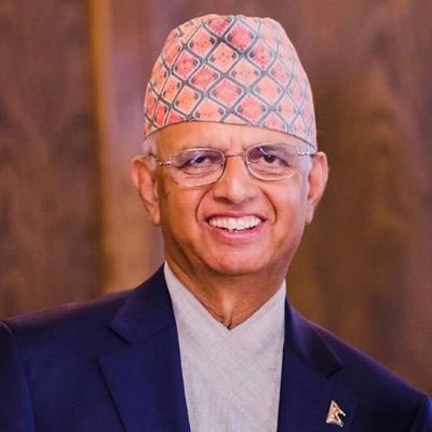Columns
Recalibrating Nepal’s foreign policy
Trends in geopolitics are changing swiftly and Nepal must be up for the challenge.
Dinesh Bhattarai
In May 1998, India carried out tests of three nuclear weapons and wrote to the United States to show ‘understanding of India’s concerns for security’ in ‘an atmosphere of distrust’ that persisted mainly due to the unresolved border problem. Pakistan conducted ‘reactive’ tests during this time. During President Bill Clinton’s visit to China in June 1998, US and China came out with a Sino-US Joint Presidential Statement on South Asia pledging to ‘continue to work closely together to prevent an accelerating nuclear and missile arms race in South Asia.’ It gave China a security role in South Asia.
US geostrategic interests regarding China were reoriented in the following years. The rise of China has been the most important geopolitical development in contemporary international relations. The Asian giant’s economic growth was so rapid and spectacular, to quote ex-Czech president Vaclav Havel, that ‘we have not yet had time to be astonished’. Chinese President Xi Jinping has challenged the United States’ global preeminence more directly than any Chinese leader since Mao Zedong and sought to build a ‘new type of major country relations,’ in its desire to what late Singapore leader Lee Kuan Yew, said, ‘share this century as co-equals with the US’
Ever since US President Barrack Obama announced in 2011 the primacy of the Asia-Pacific region in US foreign policy, labelled as a pivot to Asia or rebalance towards Asia, it was viewed as a strategy to contain the rising influence of China in the region.
South Asia is a vital region of great diversity and major civilisations. Its geopolitics is complex and provides a fertile ground for great power competition. Given the conflicting claims and competing aims of India, China and the US in the region, along with the expanding Sino-Russian partnership, the complexity gets upscaled. The root of the great games of superpowers started with the Soviet invasion of Afghanistan in December 1979. The invasion fueled the divisions in ethnically diverse Afghanistan. Terrorist attacks on America (9/11) planned from hideouts in Afghanistan led the US to launch the Global War on Terror. Washington’s preoccupation with the Global War paved the path for China to increase its diplomatic footprint by promoting connectivity and building economic corridors to encourage regional cooperation for economic growth, including through the Belt and Road Initiative (BRI) in the region. It is also the time the American leadership is turning away from international commitments on climate change, the disarmament process, and is displaying policy unpredictability.
China’s strategic investments in building ports and economic corridors, modernising airports and seaports (for example the Hambantota in Sri Lanka) are testaments of its power projection capabilities in the Indian Ocean—considered to be an artery for international commerce and energy supplies. The China Pakistan Economic Corridor (CPEC), a flagship project under the BRI, passes through the disputed territory between India and Pakistan to which India says, ‘no country can accept a project that ignores its core concerns on sovereignty and territorial integrity’.
The deep-seated rivalries between nuclear-armed India and Pakistan in South Asia are further complicated by the existence of long-standing border disputes and cross-border terrorism. The 73-days-long standoff between China and India in 2017 over disputed territory between Bhutan and China in Doklam is seen as Beijing’s attempts to make inroads into South Asia—a challenge to India which considers the region to be within its sphere of influence. Similarly, Japan, India and Sri Lanka are reported to have reached a tripartite arrangement that could lead to operating the Eastern Container Terminal at Colombo airport, in which Sri Lanka will own 51 percent and the rest will remain with Japan and India. This is said to have been born out of China’s ambitious plans for the Indian Ocean and the Indo-Pacific. This makes South Asia an epicentre of new geopolitics.
The region also has the fastest-growing economies and vibrant and emerging democracies. It holds the key to the future of the new world order. Unlike in the 19th and 20th century, the decisions made in South Asian capitals have come to be of strategic importance for global governance. From the Himalayan frontiers to the Indian Ocean the region is fast becoming a testing ground for geopolitical muscle-flexing between Nepal’s close neighbours—India and China—and the United States. The ongoing trade war between the US and China is seen in this larger geopolitical context. India, as an aspiring global power and close neighbour, appears reluctant to antagonise China and risk conflict. It appears to be in a mood to maintain a balanced approach in dealing with the US and China in the light of its broader objectives, as it will need both American and Chinese support for permanent membership in the UN Security Council, and Nuclear Suppliers Group (NSG).
Trends in geopolitics are changing swiftly. Nepal sits strategically between India and China. It should carefully, closely, and critically study unfolding developments through a wider lens. It should think of the big picture, assess what implications any developments have for the country, particularly its national interests and security. The central challenge before Nepal is to manage the sensitive and fragile geopolitics skillfully, judge every issue on its merit without fear or favour, take no sides, maintain a healthy balance, and stand out with clarity and consistency in the best interests of the nation.
***
What do you think?
Dear reader, we’d like to hear from you. We regularly publish letters to the editor on contemporary issues or direct responses to something the Post has recently published. Please send your letters to [email protected] with "Letter to the Editor" in the subject line. Please include your name, location, and a contact address so one of our editors can reach out to you.




 5.17°C Kathmandu
5.17°C Kathmandu















